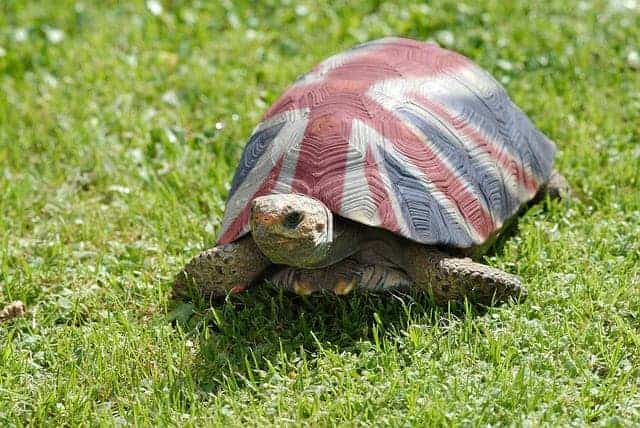
It probably won’t come as a surprise to many people to learn that tortoises, like nearly all reptiles, are native to warm climates. Why is this so? Well tortoises are cold blooded animals, meaning that they rely on the environment around them to provide the heat they need to function and survive. This is in contrast to warm blooded animals such as mammals that are able to generate their own body heat.
However, it’s important to note that this doesn’t mean lower temperatures such as those common in northern Europe and North America are necessarily harmful to tortoises; after all, even in the hottest parts of the world nighttime temperatures are often freezing cold.

If you live in the UK with it’s temperate conditions throughout much of the year, and cold wet winters, you might be wondering how well a prospective pet tortoise would cope in such conditions. The answer is that it depends on how well you care for them, and to some degree which breed of tortoise you select.
Whilst no tortoise is ideally suited to living outdoors in the UK, sub tropical breeds such as Hermann’s, Spur Thigh, and Russian tortoises are relatively hardy breeds that can live comfortably in the UK and do not require a large amount of space to live.
It’s important to note that such breeds need to hibernate, given their provenance. This doesn’t necessarily make them any harder to care for than other species, but it is something you need to be aware of.
Other Species
Tropical species such as African spur and red foot tortoises require more consistent heat and in some cases humidity than the breeds mentioned above, and are therefore more challenging to keep in the UK.
Likewise smaller tropical breeds such as the Indian Star tortoise are a highly sought after breed, but are known to be susceptible to health issues if kept in suboptimal conditions.
Keeping a Tortoise Indoors
Of course when it comes to keeping a tortoise indoors there isn’t much to distinguish between one country and another, given that conditions indoors can be artificially controlled. However, nearly all breeds of tortoise will be more healthy in the long run if they are kept outdoors, certainly after the first few years of their lives.
Keeping a Tortoise Outdoors Safely
Armed with the knowledge that tortoises are able to cope with lower temperatures at night, we know that keeping tortoises in the UK isn’t a total deal breaker, however, what effect do lower temperatures have on tortoises?
For breeds that hibernate (brumate) very low temperatures (around 5 °C, or 40 °F) encourage the tortoise to go into a state of deep sleep and reduced metabolic activity. However this is only safe when the tortoise is healthy enough to cope with such challenging conditions, and they have been sufficiently ‘fattened up’ so to speak, in the weeks leading up to hibernation.
For the rest of the year when a tortoise is not hibernating they will still go into a ‘semi hibernative’ state every night when temperatures drop close to, or even as low as the temperature for hibernation. Again, provided the tortoise has access to a healthy supply of food and water during the day, this won’t in theory cause too many issues.
Keeping a tortoise warm during the day is the bigger challenge for those living in the UK, so there are a few important things to do to ensure your tortoise warms up enough to move, eat, and digest/metabolise food.
Keeping Things Warm
First and foremost you need to house your tortoise in an are of your garden that receives a consistent dose of sunlight (or at the very least daylight!) throughout the day. This gives the ground a chance to warm up, and allows the tortoise to bask in the warmth for a prolonged period of time.
To give the ground the best chance of warming up, you should have an area of concrete, tarmac, or something like a paving slab, that will absorb and retain heat better than grass. Although tortoises are really adapted to absorb heat through their upper shell (carapace) it doesn’t hurt to have some residual natural heat penetrating through from their underside.
If at all possible you’ll want to provide an indoor area to your outdoor tortoise enclosure complete with heat source that your tortoise is able to freely come and go from.
If you’re wincing at the thought of the cost of this, then perhaps consider solar panels to power the operation, or even a ‘greenhouse’ type arrangement that retains the sun’s heat. A little outside of the box thinking goes a long way!
Keeping Your Tortoise Dry
Second to the challenge of keeping your tortoise warm is the challenge of keeping them dry.
Just like any living organism tortoises require water, like us they drink water, but they also need a degree of ambient humidity to ensure their shell and skin remains healthy.
However drinking water and slightly damp air is one thing, heavy rainfall and saturated bedding is another. Too much moisture can result in your tortoise’s shell rotting among other ailments, therefore keeping a decent portion of your tortoise enclosure elevated above ground level is essential.
The interior portion of the enclosure should form part of this elevated area, so that your tortoise can stay warm and dry when it rains, and at night
Hibernation and Over Wintering
If at this point you’re thinking your tortoise can’t possibly survive the great British winter (especially if you live in the Scottish highlands for example!), then fear not, you wouldn’t expect to leave your tortoise outside all year round.
Instead you’ll either bring your tortoise is for the winter, which is otherwise known as ‘over wintering’, or else you’ll put them into the controlled conditions required for hibernation.
Typically over wintering is used when a tortoise is deemed to be too underweight or in too poor a state of health to survive the hibernation process. When this is the case the tortoise should be brought indoors during the coldest and wettest months of the year. You will of course need to be prepared to accommodate your tortoise indoors and have the space and facilities to do so.

